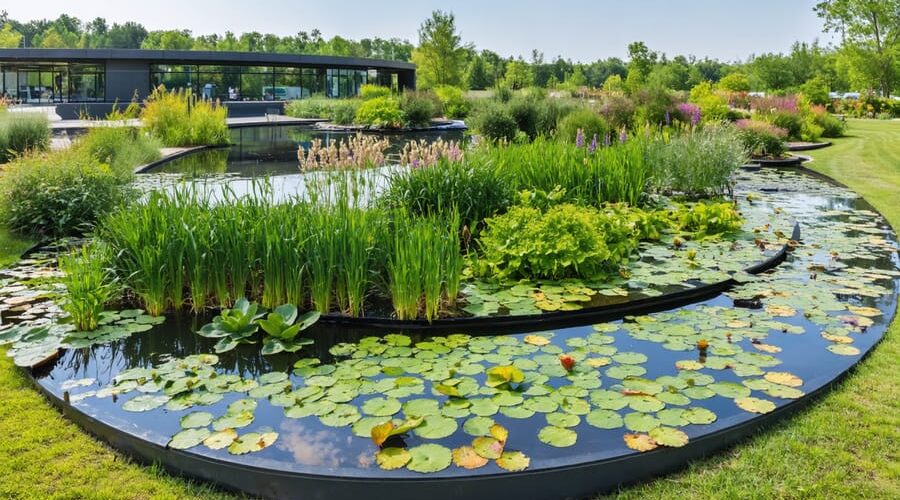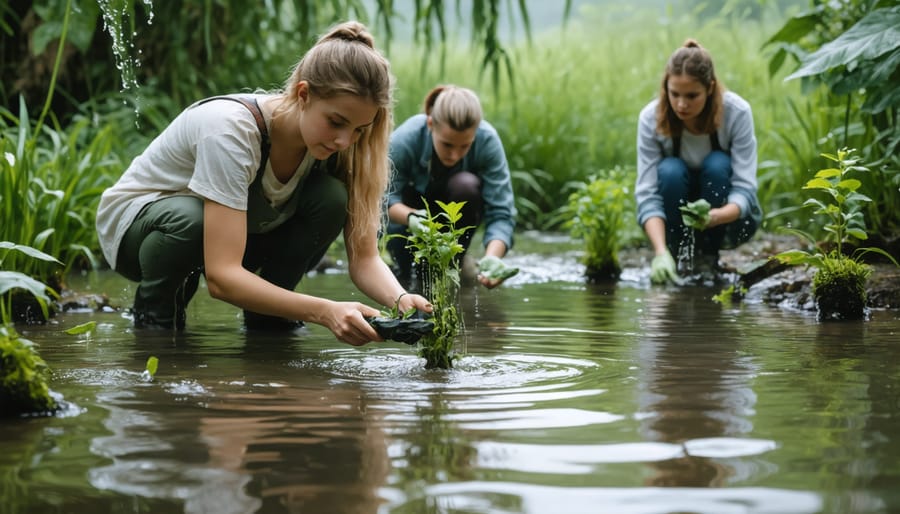
Inside Chicago’s Most Advanced Water Garden: Jardine Plant Tour Experience
Step inside Chicago’s engineering marvel, the Jardine Water Purification Plant, where over 1 billion gallons of Lake Michigan water transform into crystal-clear drinking water daily. This fascinating guided tour reveals the intricate processes that keep America’s largest surface water treatment facility running 24/7, serving nearly 5 million residents across the Chicagoland area.
From massive intake cribs two miles offshore to state-of-the-art filtration systems, visitors witness firsthand how raw lake water undergoes multiple purification stages before reaching their taps. The plant’s architectural grandeur, combined with its critical role in public health, makes this tour an eye-opening experience for anyone interested in urban infrastructure, environmental science, or engineering.
Learn how dedicated water quality experts monitor and adjust treatment processes in real-time, ensuring every drop meets or exceeds EPA standards. This behind-the-scenes look at modern water treatment technology offers unique insights into one of society’s most essential services.

The Living Laboratory: Jardine’s Water Garden Ecosystem
Native Aquatic Plants in Action
During our tour, we were amazed by the diverse collection of native water plants that play crucial roles in the Jardine plant’s natural filtration system. These living purifiers are essential components of healthy aquatic ecosystems and help clean the water naturally.
We observed cattails (Typha latifolia) forming dense stands along the settling ponds, their extensive root systems acting as natural filters to remove excess nutrients. Water lilies spread their broad leaves across the surface, providing shade that helps control algae growth while their roots absorb impurities from below.
The tour guide showed us how native rushes and sedges line the channel edges, working tirelessly to trap sediment and filter pollutants. We were particularly impressed by the pickerelweed, with its heart-shaped leaves and purple flower spikes, which not only looks beautiful but also helps remove heavy metals from the water.
What’s fascinating is that many of these plants can be incorporated into home water gardens, offering both aesthetic appeal and natural filtration benefits.
Filtration Through Flora
During our tour through the Jardine facility’s botanical section, we discovered how water purification through plants plays a vital role in the treatment process. The facility maintains several large basins filled with carefully selected aquatic plants that naturally filter water. Water hyacinths, for example, excel at removing excess nutrients and heavy metals, while cattails help break down harmful bacteria.
What’s fascinating is how these plants work together in harmony. Floating plants like duckweed form a protective canopy that reduces algae growth, while submerged plants like hornwort oxygenate the water. The root systems of these plants create an intricate network that traps sediment and provides a home for beneficial bacteria.
During the demonstration, we learned how this natural filtration process mirrors what happens in healthy pond ecosystems. The tour guide showed us how they regularly harvest these plants to maintain optimal filtering capacity, a practice that home pond owners can easily adapt to their smaller water features.

Workshop Highlights: Hands-On Learning Experience
Plant Identification Techniques
During the plant identification workshop portion of the tour, visitors learn essential techniques for recognizing common water garden plants. The expert guides demonstrate how to examine leaf structure, flower characteristics, and growth patterns – skills that prove invaluable for maintaining a healthy water garden at home.
Participants are taught to identify emergent plants like cattails and rushes by their distinctive vertical growth and leaf arrangements. For floating plants such as water lilies and lotus, the focus shifts to leaf pad shapes and flower structures. The guides share a simple yet effective method of categorizing plants into four main groups: submergent, emergent, floating-leaved, and free-floating.
One particularly helpful technique involves observing the relationship between plant location and water depth. Visitors learn that certain species thrive in specific zones, from deep water to marshy edges. This knowledge helps in planning appropriate plant placement in home water features.
The workshop also covers seasonal identification markers, teaching participants how plants change appearance throughout the year. Digital resources and plant identification apps are recommended for continued learning at home. Guests receive a handy reference guide featuring common water garden plants, complete with photos and key identifying characteristics.
These identification skills not only enhance the tour experience but also empower visitors to make informed choices when selecting plants for their own water gardens.
Water Quality Testing Demonstrations
During this fascinating segment of the tour, visitors participate in hands-on water quality testing demonstrations using aquatic plants as natural indicators. The knowledgeable staff explains how certain plants react to different water conditions, making them excellent bio-indicators for water quality assessment.
Participants learn to identify key plant species like duckweed and water hyacinth, which are particularly sensitive to water quality changes. The demonstration shows how these plants respond to various pollutants, pH levels, and nutrient concentrations. Visitors get to examine samples under microscopes and compare plant specimens from different stages of the purification process.
One of the highlights is the interactive testing station where guests use simple test kits to measure water parameters themselves. The experience includes checking for chlorine levels, pH balance, and dissolved oxygen content – the same parameters that plant life responds to in natural environments.
The session concludes with a practical demonstration of how these testing methods can be applied in home water gardens and ponds. Participants receive a handy guide showing which common aquatic plants serve as natural water quality indicators and how to interpret their growth patterns and appearance. This knowledge proves invaluable for maintaining healthy water features at home while understanding the sophisticated processes employed at the Jardine facility.

Applying Jardine’s Lessons to Home Water Gardens
Scaling Down Professional Methods
After touring the Jardine facility, you might wonder how to apply these impressive purification methods at home. While we can’t match the scale of industrial operations, we can adapt key principles to create your own living pond with clean, healthy water.
Start with a multi-stage filtration system that mimics industrial processes. Use a combination of mechanical filters to remove debris, followed by biological filtration using beneficial bacteria. Consider adding a UV clarifier – a smaller version of the industrial UV treatment systems – to control algae growth.
For chemical treatment, opt for natural alternatives to industrial methods. Instead of massive chlorination systems, try barley straw or beneficial plants that naturally purify water. Water lilies and cattails work like nature’s filters, absorbing excess nutrients that could cause algae blooms.
Aeration is crucial but doesn’t require industrial-sized equipment. A simple fountain or waterfall creates movement and introduces oxygen, much like the massive aeration chambers at Jardine. For larger ponds, consider a small air pump with diffusers.
Monitor water quality regularly using home testing kits – they’re like simplified versions of the professional testing equipment we saw on the tour. While not as precise as industrial systems, they’re perfect for maintaining healthy water in your backyard oasis.
Plant Selection Guidelines
Drawing inspiration from Jardine’s proven water purification methods, selecting the right plants for your water garden is crucial for maintaining clean, balanced water. Start with hardy submerged plants like hornwort and anacharis, which help oxygenate the water and remove excess nutrients. These workhorses of the water garden typically need minimal maintenance and thrive in most conditions.
For surface coverage, consider floating plants such as water lilies or lotus. These not only add visual appeal but also provide shade that helps control algae growth and maintains cooler water temperatures. The Jardine facility demonstrates that a mix of 40-60% surface coverage creates optimal conditions.
Along the edges, incorporate marginal plants like rushes, iris, and cattails. These plants excel at filtering water through their root systems, much like the natural filtration processes showcased at Jardine. Choose varieties based on your water depth and climate zone for best results.
Remember to include beneficial bacteria-harboring plants like water mint and marsh marigold. These plants support the natural biological filtration process, similar to how Jardine uses biological treatment in their purification systems.
For maximum effectiveness, introduce plants gradually over several weeks, allowing each group to establish before adding more. This method, inspired by Jardine’s systematic approach, helps maintain water quality while preventing any sudden changes in the ecosystem.
The Jardine Water Purification Plant tour offers an invaluable glimpse into the fascinating world of large-scale water treatment. From understanding the intricate filtration processes to learning about sustainable water management practices, participants walk away with knowledge that can be applied to their own water garden projects. The hands-on workshop components make complex concepts accessible and practical, while the facility’s impressive scale helps visitors appreciate the engineering marvel behind clean water production. Whether you’re a DIY enthusiast or simply curious about water purification, this tour provides both inspiration and practical knowledge. The experience reinforces the importance of water quality in our daily lives and equips visitors with tools to make better decisions about their own water features and gardens. It’s truly a must-visit destination for anyone interested in water management and sustainable practices.
